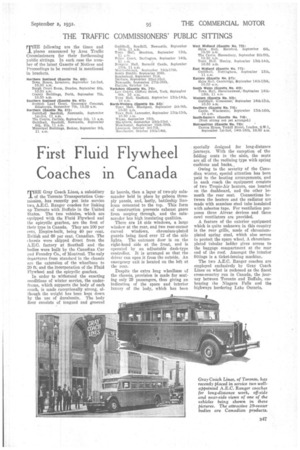First Fluid Flywheel Coaches in Canada
Page 65

If you've noticed an error in this article please click here to report it so we can fix it.
TEE Gray Coach Lines, a subsidiary of the Toronto Transportation Commission, has recently put into service two, A.E.C. Ranger coaches for linking up Toronto with Buffalo in the United States. The two vehicles, which are equipped with the Fluid Flywheel and the epicyclic gearbox, are the first of their type in Canada. They are 100 per cent. Empire-built, being 40 per cent. British and 60 per cent. Canadian. The chassis were shipped direct from the A.B.C. factory at Southall and • the bodies were built by the Canadian Car and Foundry Co., of Montreal. The only departures from standard in the chassis are the extension of the wheelbase to 20 ft. and the incorporation of the Fluid Flywheel and the epicyclic gearbox.
In order to withstand the exacting conditions of winter service, the underframe' which supports the body of each coach, is made exceptionally strong, although the weight has been kept down by the use of duralumin. The body floor consists of tongued and grooved
fir boards, then a layer of two-ply salamander held in place by gaboon threeply panels, and, lastly, battleship linoleum cemented to the top. This form of construction prevents exhaust gases from seeping through, and the salamander has high insulating qualities.
There are 14 side windows, a large window at the rear, and two rear-corner carved windows, chromium-plated guards being fixed over 12 of the side lights. The entrance door is on the right-hand side at the front, and is operated by an adjustable dash-type controller. It is arranged so that the driver can open it from the outside. An emergency exit is located on the left at the rear.
Despite the extra long wheelbase of the chassis, provision is made for seating only 21) passengers, thus giving an indication of the space and interior luxury of the body, which has been specially designed for long-distance journeys. With the exception of the folding seats in the aisle, the seats are all of the reclining type with spring cushions and backs., Owing to the severity of the Canadian winter, special attention has been paid to the heating arrangements, and in each coach the equipment consists of two Tropic-Air heaters, one located on the dashboard, and the other beneath the rear seat. Connections between the heaters and the radiator are made with seamless steel tube insulated with asbestos tape. For ventilation purposes three Airvac devices and three cowl ventilators are provided.
A feature of the exterior equipment which is quite unknown in this country is the rear grille, made of chromiumplated spring steel, which also serves to protect the spare wheel. A chromiumplated tubular ladder gives access to the baggage compartment at the rear end of the roof. Amongst the interior fittings is a ticket-issuing machine., The two A.E.C. Ranger coaches are employed exclusively by Gray Coach Lines on what is reckoned as the finest cross-country run in Canada, the journey between Toronto and Buffalo embracing the Niagara Palls and the highways bordering Lake Ontario.




































































































